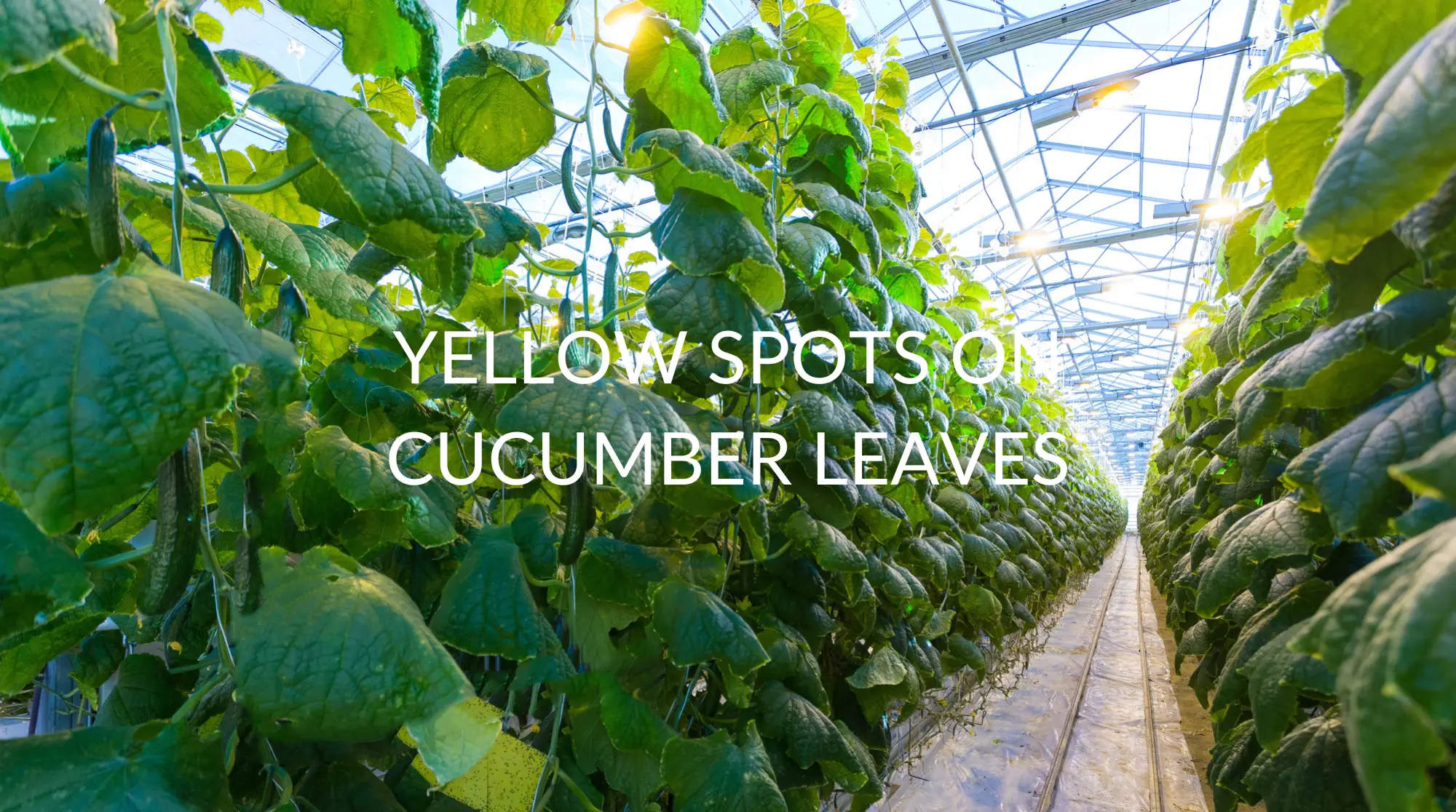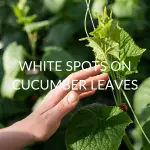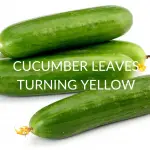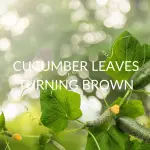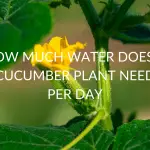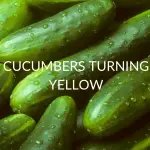You’re mid-season in your cucumber’s long growing process. You’re anticipating the freshly cut slices and can’t wait to taste the subtle, sweet juices in your mouth. Then you notice yellow spots on your cucumber leaves. Before you throw in your gardening gloves, find out what you need to know about the yellow spots on your cucumber leaves.
Primarily fungal infections caused by different culprits, they can eventually turn all your leaves brown and, in severe cases, can cause withering and death, infecting older leaves first.
Unfortunately, you can’t completely kill what has already started to spread. However, this article explores the various causes and methods to treat and prevent the yellow spots on your cucumber leaves.
What Are The Yellow Spots On My Cucumbers?
The yellow eye sore on your cucumbers can indicate an infection that has started breeding on its leaves. There are different types of pathogens, distinguished by their shapes, yellow markings, and how they survive and thrive.
Different Pathogens And How They Appear
Typically yellow but can also show up as light green or white, the water mold known as Downy Mildew appears as angular blotches. These spore-spreading viruses love temperate weather and thrive on shade and moisture but become less threatening in cold weather. Just as invasive and known for its rapid spreading, the Bacterial Wilt has yellow, wilting leaves that appear to be drying out. When leaves are cut open, you can identify the wilting fungus by its milky consistency. Another pathogenic culprit is the Cucumber Mosaic Virus which color your cucumbers and their leaves into white, yellow, or green lines and patterns. The distinct marks and yellowness on green veins indicate the virus, which can spread the infection onto healthy plants.
Pathogens You Can’t See
Anthracnose, a pesky fungus, breeds in regions with high humidity and can lay dormant in the winter on plant waste and continue its life cycle in the spring. They are characteristically circular yellow markings that grow as the disease progresses. Also breeding out of sight is the Fusarium Wilt. Its infection starts from the root system and gradually cuts off the water flow to the rest of the plant, which can suddenly turn the leaves yellow and wilt. Another root system invader and also congesting the plant’s vasculature is Verticillium Wilt. The irregularly shaped yellow spots spread their spores in moist, warm climates and germinate through water, insects, and equipment. These relentless pathogens can survive in the soil, using weeds, and plant debris as hosts over the winter. Yikes!
What Causes Yellow Spots On Cucumber Leaves?
There are many reasons the yellow spots appear, varying from environmental factors, insect predation, maintenance, and the health status of your plants. The triggers and symptoms can occasionally lay dormant and go unnoticed until it is too late.
Moisture, Climate, And Environment
We all know plants need sunshine, and cucumber leaves are no exception. Without proper sunlight, a condition called chlorosis caused by an insufficient amount of chlorophyll —which gives the green color to plants, can occur and eventually start to turn the plant yellow. However, too much heat or humidity can cause fungal and bacterial spores to flare up and germinate.
Insects As Hosts
With the arrival of warmer weather, spring usually heralds an emergence of insects in hibernation. Crop pests like cucumber beetles are one of them. These same critters can pick up bacteria and cause infection migration from one plant to another. The long winter days don’t do much either since the bacteria can survive by nesting in the beetles’ stomachs.
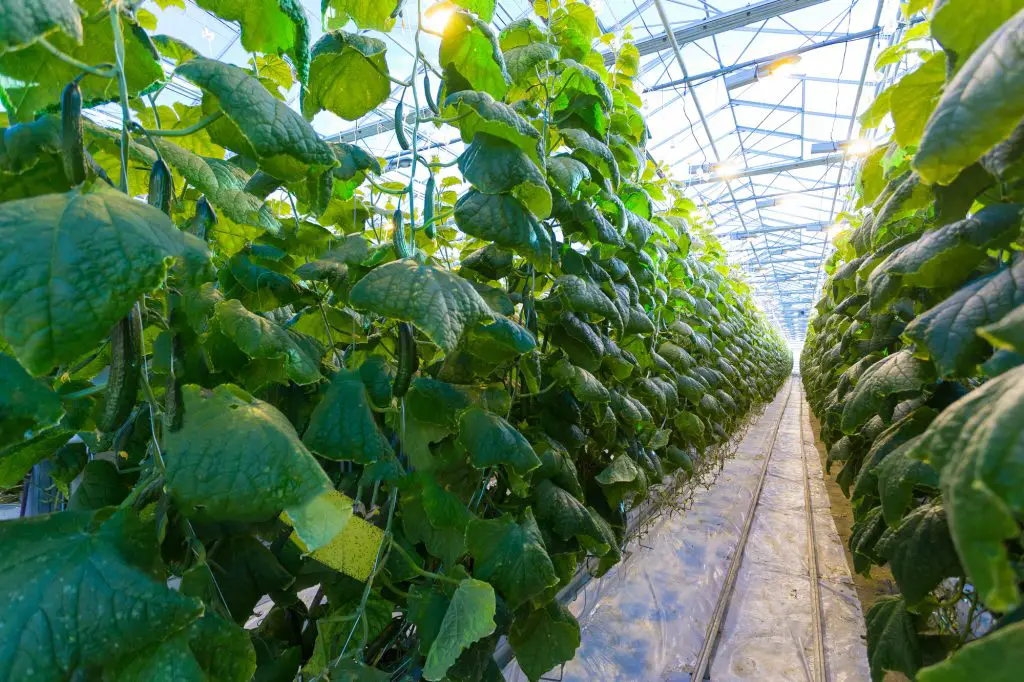
Improper Practices
Unsanitary tools and gardening materials can also cause yellow spots on cucumber leaves. They can be breeding grounds for insects. Aphids that feed on the plant love to hang out in these germ-infested areas, potentially transferring toxins into healthy plants. Humans can also transport viruses onto their green growth.
Contamination From Essential Sources
Soil and water are also life sources for the prevalent bacterial, viral and fungal pathogens. The contamination can spread through other elements. For example, the fungus Alternaria Leaf Blight can be swept up, travel via air, and disperse toxins to other areas of growth.
Overall Health Condition
It could also be as simple as giving your plant too much water. When there is a flood of water at the roots, it’s unable to absorb nutrients, which can cause wilting and yellowing pigment on your plants. In addition, an excessive amount of watering can stimulate mildew growth in cucumber plants.
How Do You Treat Yellow Spots On Cucumber Leaves?
Removing Excessive Growth
Pruning and trimming are always an excellent way to maintain the health of your garden. It helps eliminate rot, debris, and infected areas before the disease spreads to other plants.
Organic Solutions
Use organic fungicide with natural ingredients. You can mix soap, baking soda, and vinegar into the water. This DIY solution is an effective way to clean and control infectious growth.
Copper Fungicide
Another organic option is copper fungicide. Used for pathogens like Downy Mildew, it penetrates the skin of the plant to control the fungal spores from breeding further.
Natural Repellent
An insecticide is also an effective way to decrease the beetle pandemic. If you’re concerned about toxins, natural repellents like neem oil or vegetable oil can do the job sufficiently.
Essential Minerals
Your cucumber patch could be lacking essential minerals. Give it a bit of a treat to increase levels of iron, magnesium, zinc, and potassium. With a bit of Epsom salt, sulfur, and magnesium mixed in water, you can replenish the soil or use it to spray the base of the plant.
Water Management
Use a watering system like a soaker hose or drip irrigation to help keep leaves dry and fend off mold and bacteria. They work well in evenly spaced and row-planted gardens.
An Optimal Environment
Air circulation and appropriate spacing between plants and soil is another way to curb infections. Using trellising, raised nursery beds, or adding wider rows can give your plants the breathing room and sprawling space required for optimal health.
How To Prevent Spots On Your Cucumber Leaves
Use Disease-Free Seeds
Nip it in the bud(literally) by planting certified virus-free seeds. According to the University of Minnesota, seeds come in all sorts of disease-resistant varieties. Each one has a specific genetic makeup that reflects its ability to defend itself against pathogenic enemies. Thus, choosing the appropriate one is critical.
Cover Up Your Plants
Make your plants inaccessible to pests by using plant and row covers. The mesh material works like a climate control duvet for your plants, protecting your greens from the cold weather or too much heat from the sun.
Uprooting The Main Attraction
Weeds are not only invasive but attract unwanted pests to your garden. Getting rid of them will make your nursery less attractive to the potentially infected migrating hosts.
Introducing Friendly Green Neighbors And Adding Bad Ones Too
You can solve your aphid and beetle problems by planting annoying neighbors like tansy or radish. Planting friendly ones is also a solution. Common beans and peas maximize nitrogen, which helps with healthy plant growth and foliage.
Sanitation And Maintenance
Sanitary practices are sure ways to prevent the spread of bacteria and fungus. Clean your tools after every use and clear out bacteria-loving materials in your garden. Your clothes can also be susceptible to pathogens.
What To Avoid
If you can, it is a good idea to avoid grafting. Some viruses start from the root system and only appear in their yellow staining leaf stages until later. Marrying two plants can give birth to a whole new threat and start an undetected invasion.
FAQ
Will Yellow Spots on Cucumber Leaves Affect Fruit?
The good news is that if your plant has sickly leaves and is yet to produce cucumbers, it may not have enough nutrients to carry offspring. The bad news is that if the fruit has already flowered, according to The University of Michigan, the virus can spread itself onto the fruit.
Are Cucumbers Still Edible When There Are Yellow Spots on Leaves?
Yellow spots on cucumber leaves indicate a whole host of problems you can treat to salvage the patch. However, when it is caused by pathogens and the infection has spread to the fruit, according to the University of Massachusetts, it causes internal fruit decay, consequently making the fruit inedible.
Summary
The yellow spots on cucumber leaves are caused by a host of elements. Amongst them are viral infections, which can be spread through contamination via air and migrating hosts. Insects like spider mites and aphids are also culprits, along with climate and environmental conditions. Consequently, once the damage is done and decay has taken place, there’s nothing you can do to eliminate it completely. But treatments like natural insecticides and pesticides can help stop infectious outbreaks. By also taking preventative measures like introducing helpful repelling plants and vegetation, your cucumber garden can continue to thrive into the season.

